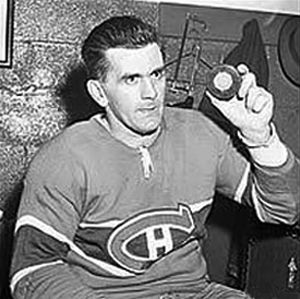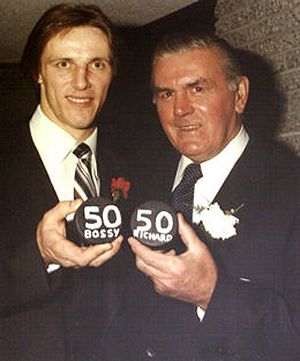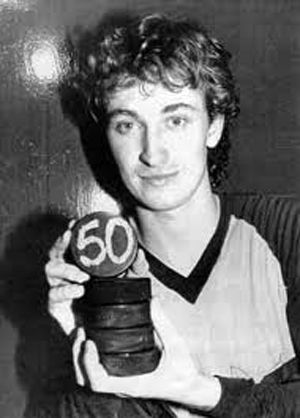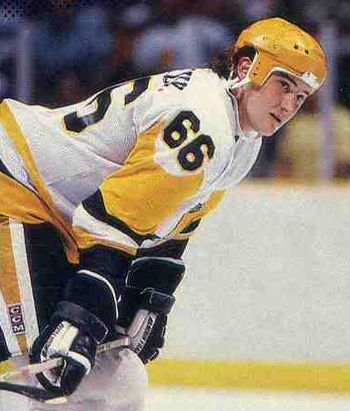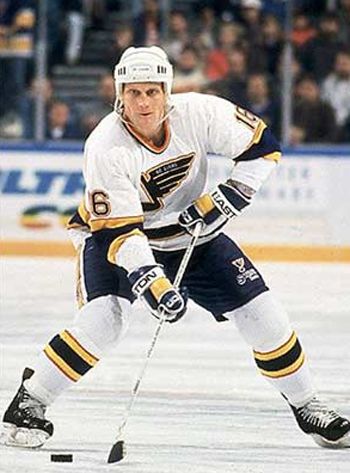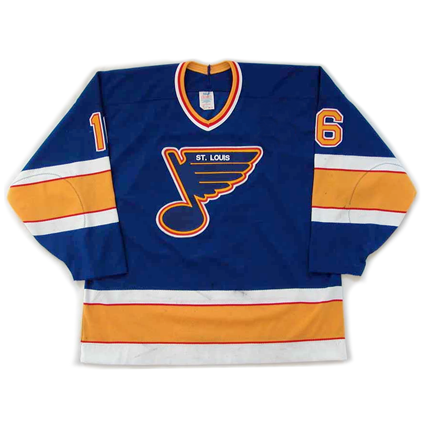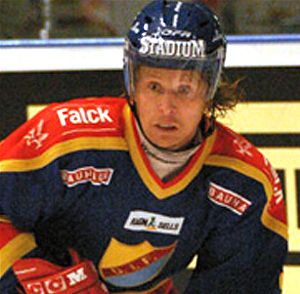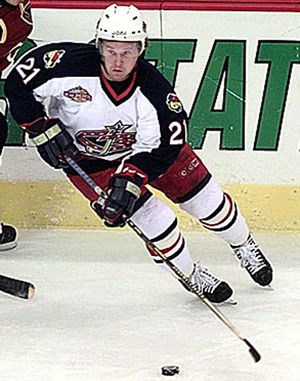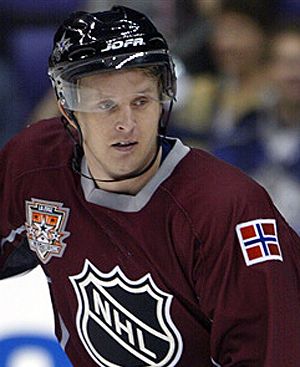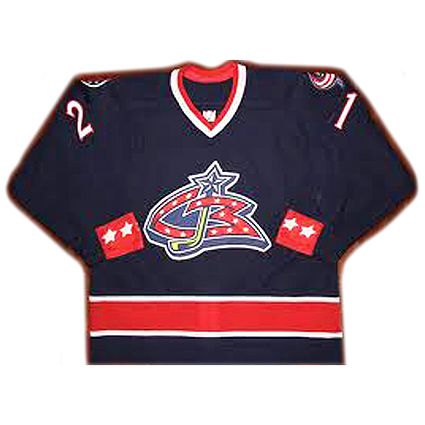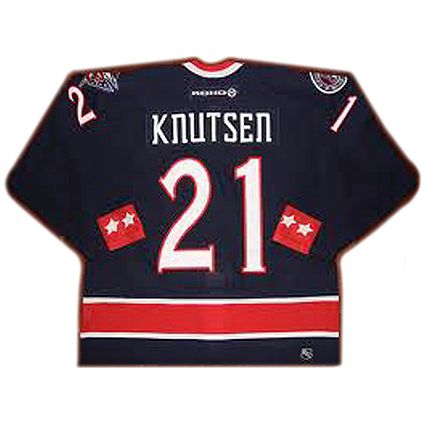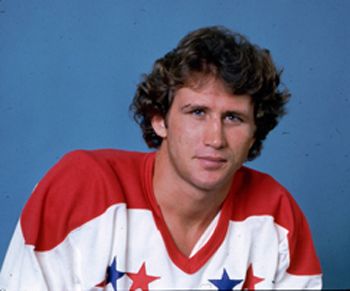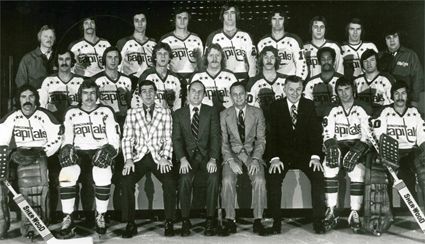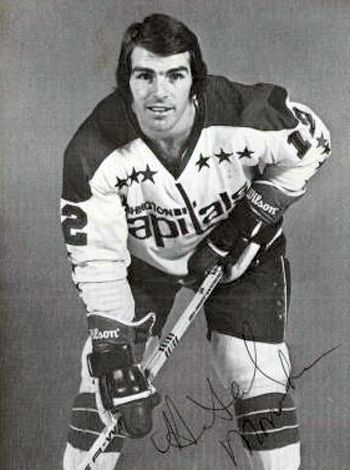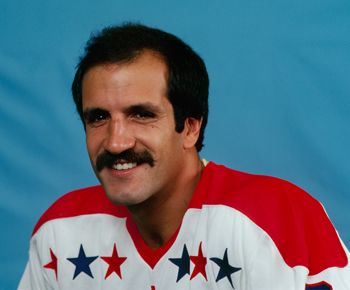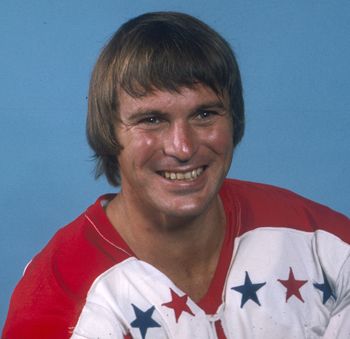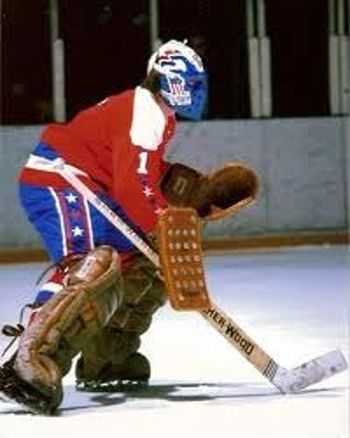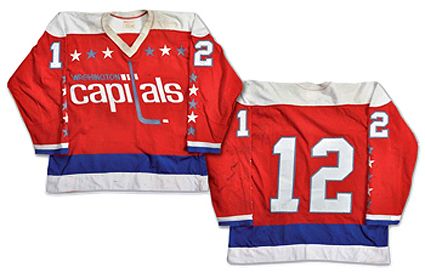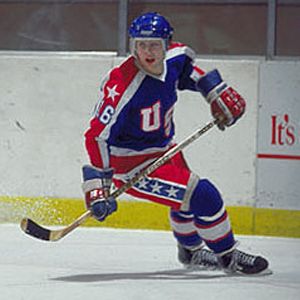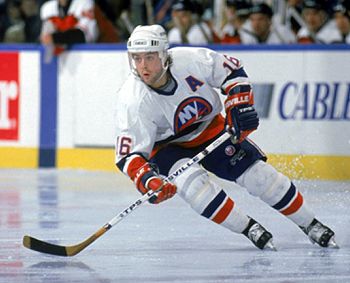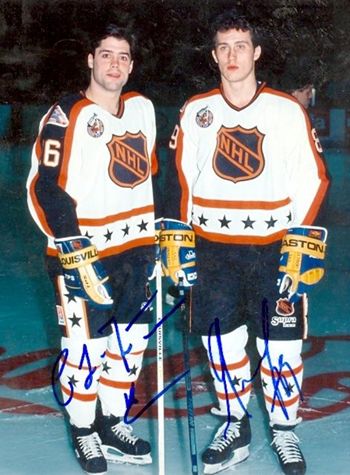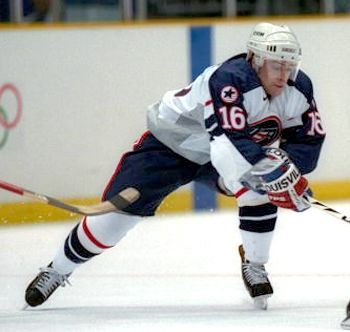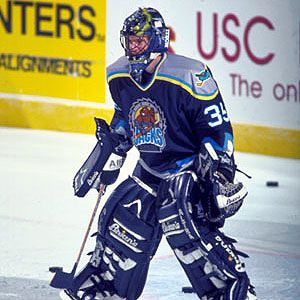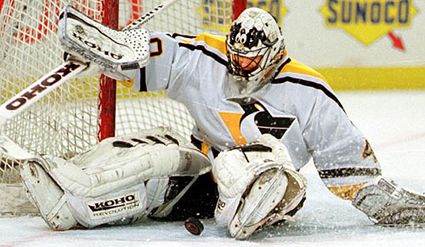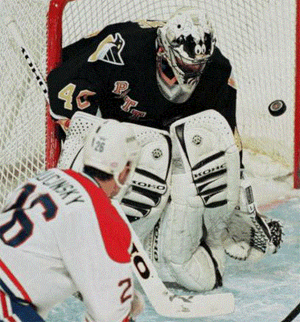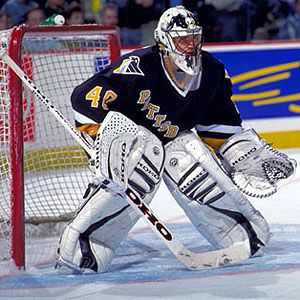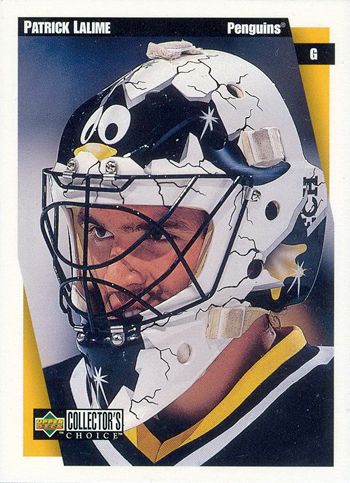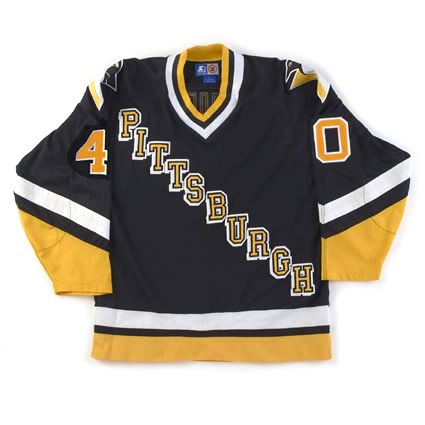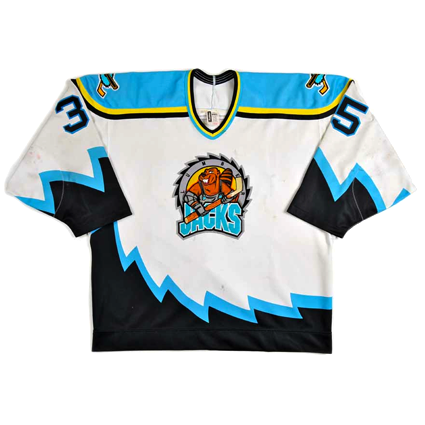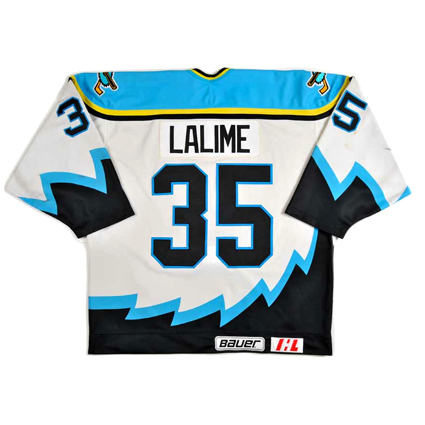Patrick Lalime played three seasons with the Shawinigan Cataractes, beginning in the 1991-92 season finishing with a high of 22 wins in 1993-94. After his second season in Shawningan, Lalime was drafted by the Pittsburgh Penguins in the 1993 NHL Entry Draft in the 6th round, 156th overall.
For the 1994-95 season, Lalime joined the Hampton Roads Admirals of the ECHL. For the first half of the season he played well, posting a 15-7-3 record, earning a promotion to the IHL, where he became a member of the Cleveland Lumberjacks. He stayed with the Lumberjacks for the 1995-96 season and finished with a 20-12-7 record in 41 appearances. He was called up to the Penguins twice during the season, serving as a backup but did not see any playing time.
Lalime while with Cleveland
He returned to Cleveland for a third season in 1996-97, but after two months he was recalled by Pittsburgh. His NHL debut came in relief of Ken Wregget on November 16, 1996.
On December 6th, he made his second appearance, again in relief of Wregget, as the Penguins were trailing 2-0 after one period against the Washington Capitals. The Penguins came back with two goals in the second period and out scored the Capitals 3-1 in the third period to win the game 5-3, earning Lalime the first victory of his career, having made 16 saves on 17 shots.
He was rewarded with the start in the Penguins next game on December 7th against the Mighty Ducks of Anaheim. After trailing 3-2 after two periods, the Penguins rallied for three goals in the third period to earn Lalime his second consecutive victory, 5-3.
Wregget started on December 10th, but Lalime got the start the following day against Anaheim. With the game at 4-3 in the second period, Pittsburgh pulled away for a 7-3 win, Lalime's third.
Two days later, Lalime grabbed the headlines following a 4-0 shutout of the San Jose Sharks, stopping all 20 Sharks shots for his first career shutout and fourth win.
Despite the shutout, Wregget started in a 2-1 loss to the Chicago Blackhawks on the 15th and was the losing goaltender on the 17th after giving up 6 goals to the Boston Bruins before being relieved by Lalime in the third period. Wregget rebounded with a shutout on the 19th over the St. Louis Blues.
Lalime returned to the crease on December 21st, getting the win over the Sharks 3-1 for his fifth win. Wregget eked out a win on the 23rd, 6-5, but was yanked after the first period trailing to the Montreal Canadiens 3-0. Lalime stood tall, blanking the Canadiens the rest of the way, making 18 saves and one more in overtime as the Penguins fought back to tie the game with three third period goals to earn Lalime a tie.
He got the start two days later, and earned his 6th win and second shutout with a 21 save performance over the Buffalo Sabres. That earned him another start on the 30th, a game not sealed until an empty net goal by
Mario Lemieux for a 5-3 Penguins win, Lalime's 7th.
The first game of the new year arrived on January 2, 1997 and Lalime was in the net for his third straight start as the Penguins blitzed the New Jersey Devils, chasing veteran goaltender
Martin Brodeur on their way to a 6-1 win.
The Tampa Bay Lightning were the next to fall to the streaking Penguins on the 4th by a score of 7-3, with Lalime once more getting the start, his 9th win which ran his unbeaten streak to ten, again earning him attention on a national scale.
Staying with the hot hand, head coach
Eddie Johnston again went with Lalime, who, despite giving up the first two goals to the New York Islanders, settled down and let the Penguins offensive juggernaut go to work, scoring four times in the second period to regain the lead on their way to an eventual 5-3 win, Lalime's 10th win and 12th without a loss and now within sight of the current record of 14.
January 11th saw Pittsburgh come from behind twice to tie the Ottawa Senators to keep Lalime's undefeated streak alive at 13, now just one shy of the record. The tie ended the Penguins winning streak at six.
With all eyes upon him, he tied the record for the longest unbeaten streak at the start of a career first set by the Montreal Canadiens
Ken Dryden (12 wins and 2 ties) in 1971, later equalled by
Ross Brooks of the Boston Bruins (11 wins and 3 ties) in 1973, following a 3-1 win over the Dallas Stars on the 14th.
Lalime then set the record in style the very next day with a 20 save performance to shutout the Hartford Whalers 3-0. The rookie's record now stood at an unbelievable 13-0-2 as his every start was now the subject of lengthy discussions on the sports channels in both the United States and Canada.
His next start would not be until this date in 1997, six days after his previous game due to a break in the schedule to accommodate the 1997 NHL All-Star Game. The Calgary Flames did all they could do to dominate Pittsburgh that night outshooting the Penguins 51-24. Calgary tied the game with just under four minutes remaining, but Stu Barnes' 11th goal of the season just 23 seconds later put Pittsburgh back on top 3-2. Ron Francis sealed the victory with an empty net goal with 24 seconds left to push Lalime's won/loss record to 14-0-2 and his undefeated streak to a new mark of 16 straight after his 49 save performance.
Two nights later the dream came to an end when the defending Stanley Cup champion Colorado Avalanche came to The Igloo. Colorado led 3-0 after two periods, but the Penguins stormed back in the third on goals by Francis, Joe Mullen and Joe Dziedzic in under 14 minutes to force overtime before Colorado's Valeri Kamensky ended the streak at 3:55 of overtime.
Lalime would come back down to Earth following his record setting run, finishing the season at 21-12-2. He was unable to agree with Pittsburgh on a contract for the following season and never played for the Penguins again.
Lalime was always known for his distinctive masks
After spending the following season of 1997-98 with the Grand Rapids Griffins of the IHL, his rights were traded to the Mighty Ducks, but failed to make their roster and spent the 1998-99 season with the Kansas City Blades, also of the IHL, where he led the league in wins with 39. Following the season he was traded to the Ottawa Senators, where he would play for the next five seasons, which included setting the Senators team record for most wins in a season with 39, before moving on to St. Louis, Chicago and Buffalo to finish out his 12 year NHL career with exactly 200 wins and 35 shutouts.
Today's featured jersey is a 1996-97 Pittsburgh Penguins Patrick Lalime jersey. Following their back to back Stanley Cup championships in 1991 and 1992, the Penguins debuted a brand new jersey set and modernized logo. The road jersey was a terrific blending of the original Penguins diagonally lettered jerseys from the 1967-68 season, done in the striping pattern similar to their blue 1974-75 jerseys, only now in their then current black and yellow colors and adorned with their new "robo-penguin" logo on the shoulders. This really sharp jersey was used from 1992-93 until 1996-97 until being replaced by the team's then alternate jersey.
Bonus Jersey: Today's bonus jersey is a 1995-96 Cleveland Lumberjacks Patrick Lalime jersey. This was the first season for the Lumberjacks new identity package, as for the club's first two seasons they wore an identical jersey to today's featured jersey, only with "Cleveland" substituted for "Pittsburgh".
Along with the new, cartoonish mascot logo, the club also developed their own, color scheme of light blue and black with the "buzz saw" striping pattern on the arms and waist, creating one of the most unique jerseys in IHL history. One wonders though, why the designers chose to go with such a basic number font instead of a more playful one like the
Manitoba Moose or
Utah Grizzlies.
This jersey style would remain in use through the 2000-01 season when the IHL folded, and the Lumberjacks were not one of the clubs absorbed into the AHL, ending their nine year run.
Today's video section begins with highlights of Lalime's three consecutive playoff shutouts.
Next, Lalime makes a stellar glove save against the Canucks Pavel Bure while still a member of the Penguins.

